#Menominee River
Explore tagged Tumblr posts
Text
Indigenous People's Day

DR. HENRIETTA MANN Cheyenne
On this Indigenous Peoples' Day, we are featuring Matika Wilbur’s recent publication Project 562: Changing the Way We See Native America, published by Ten Speed Press in 2023. Wilbur (b. 1984) is a visual storyteller and member of the Swinomish and Tulalip peoples of coastal Washington. She holds a degree from the Brooks Institute of Photography alongside a teaching certificate that has shaped her style of educating through narrative portraits.
Project 562: Changing the Way We See Native America, a book born from a documentary project of the same name, resolves to share contemporary Native issues and culture. In 2012 Wilbur set out from Seattle to visit and photograph all 562 plus Native American sovereign territories in the United States.
Wilbur’s engagement with the communities she visited resulted in the creation of hundreds of dynamic portraits and documentation of conversations about “tribal sovereignty, self-determination, wellness, recovery from historical trauma, decolonization of the mind, and revitalization of culture.” She refers to her portraiture approach as “an indigenous photography method” that includes several hours and sometimes days of interaction with the participants, an exchange of energy and gifts, and asking sitters to choose their portrait location. The outcome is a stunning collection of Native narratives and portraits.
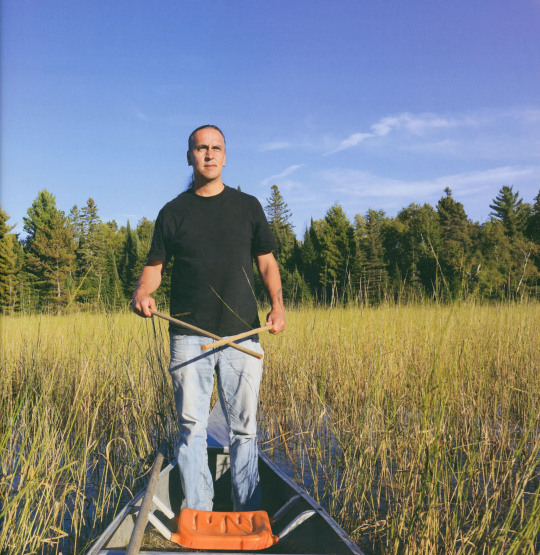
GREG BISKAKONE JOHNSON Lac Du Flambeau Band of Lake Superior Chippewa Indians
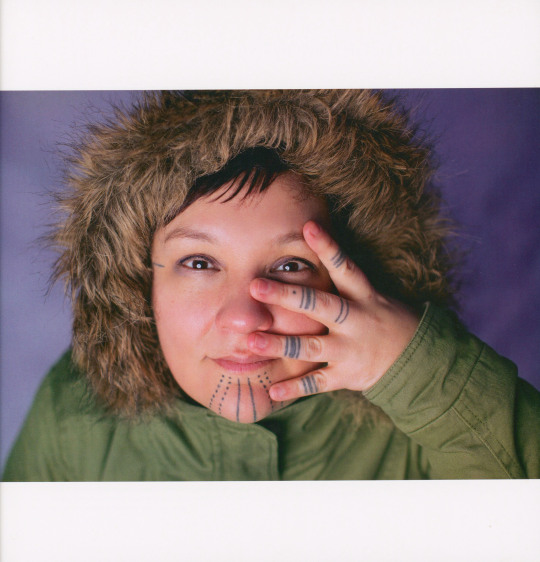
HOLLY MITITQUQ NORDLUM Iñupiaq
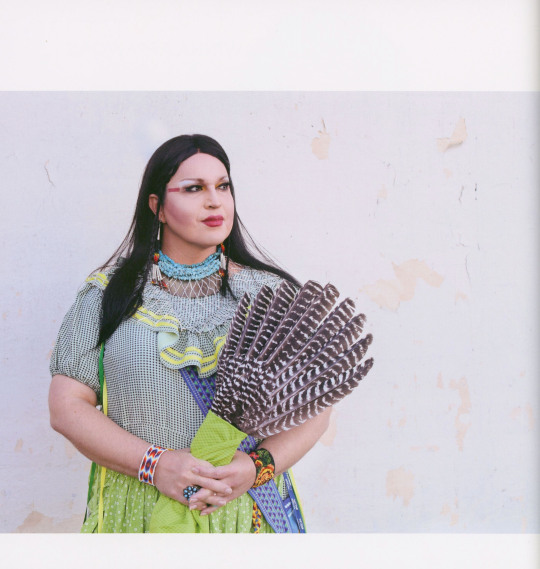
J. MIKO THOMAS Chickasaw Nation

MOIRA REDCORN Osage, Caddo

HELENA and PRESTON ARROW-WEED Taos Pueblo/Kwaatsaan, Kamia
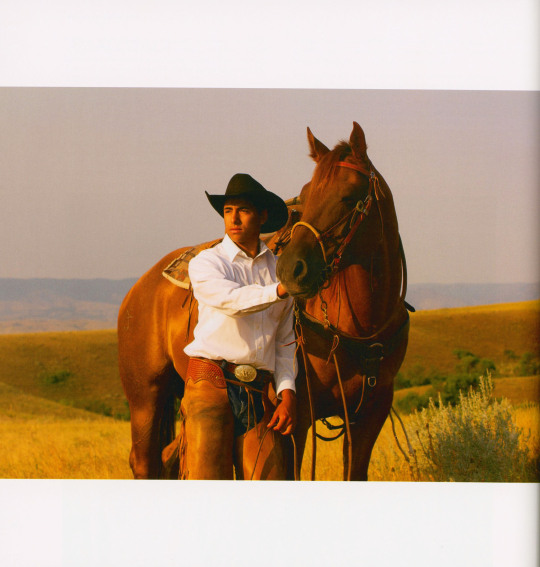
STEPHEN YELLOWTAIL Apsáalooke (Crow Nation)
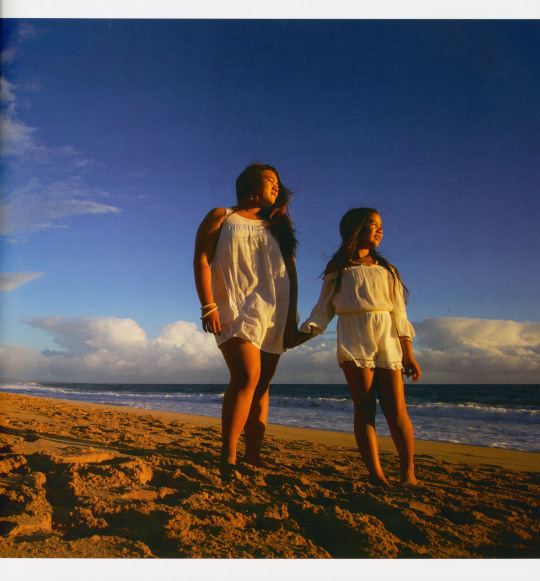
LEI'OHU and LA'AKEA CHUN Kānaka Maoli
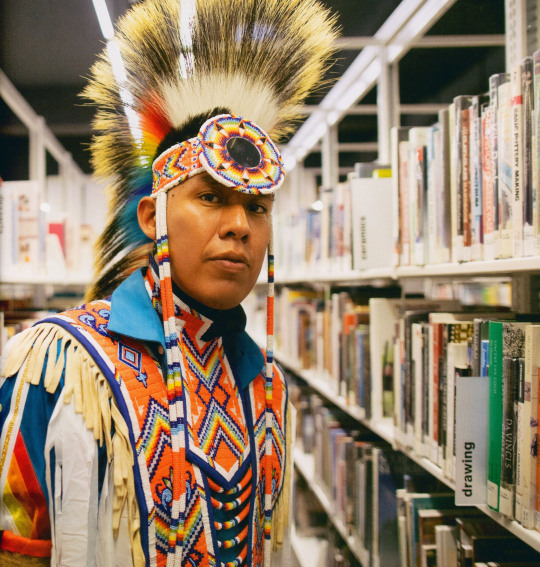
ORLANDO BEGAY Diné
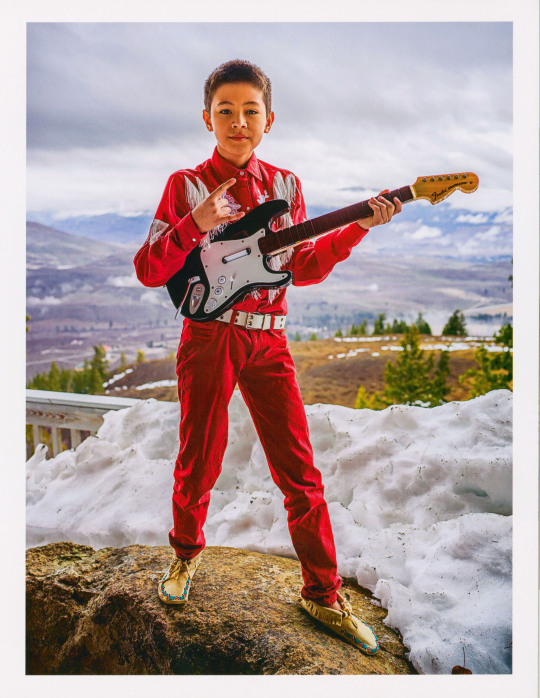
KALE NISSEN Colville Tribes
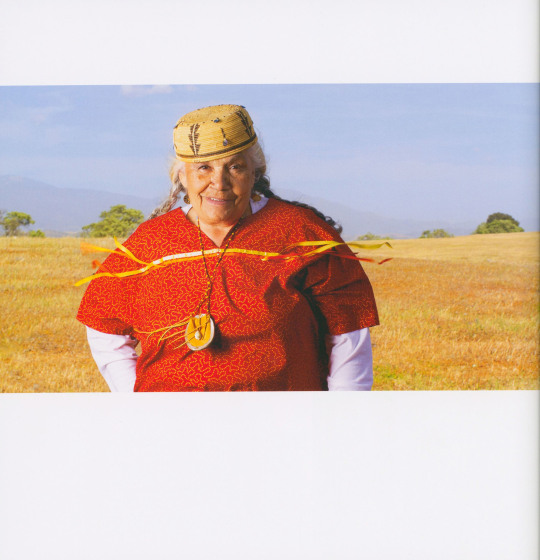
GRACE ROMERO PACHECO Santa Ynez Band of Chumash Indians
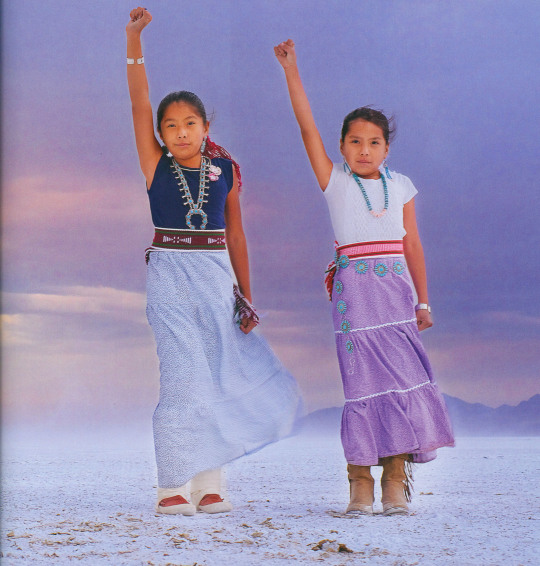
ISABELLA and ALYSSA KLAIN Diné
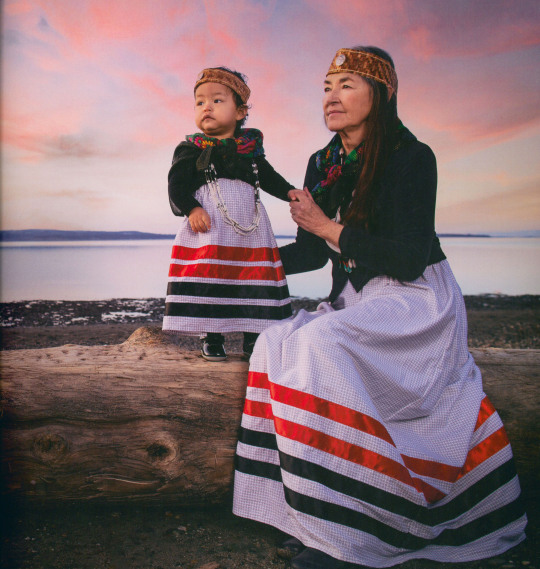
NANCY WILBUR Swinomish
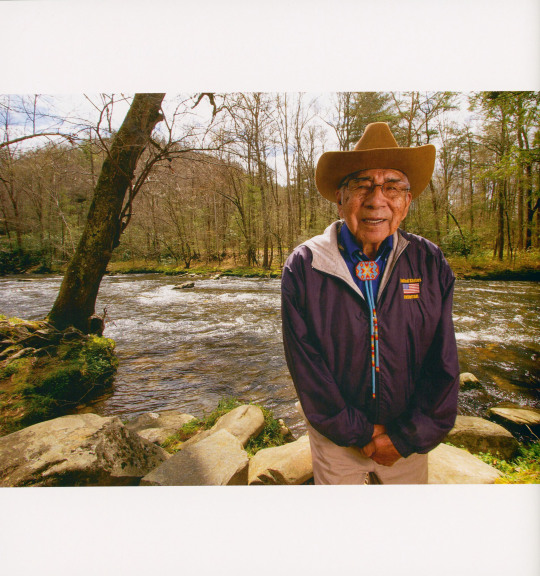
DR. JEREMIAH "JERRY" WOLFE Eastern Band of Cherokee Indians
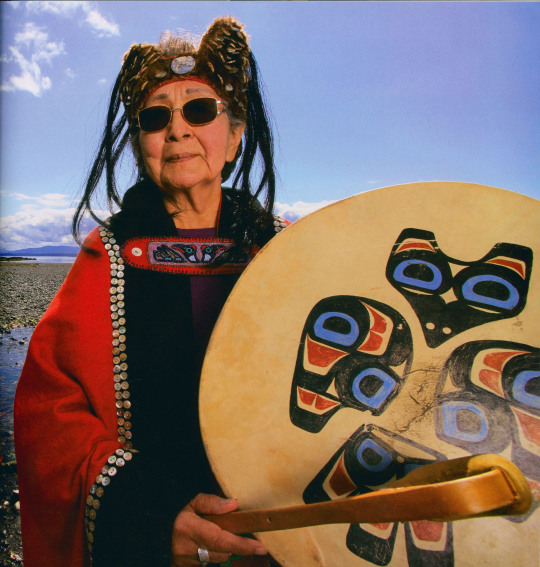
RUTH DEMMERT Tlingit
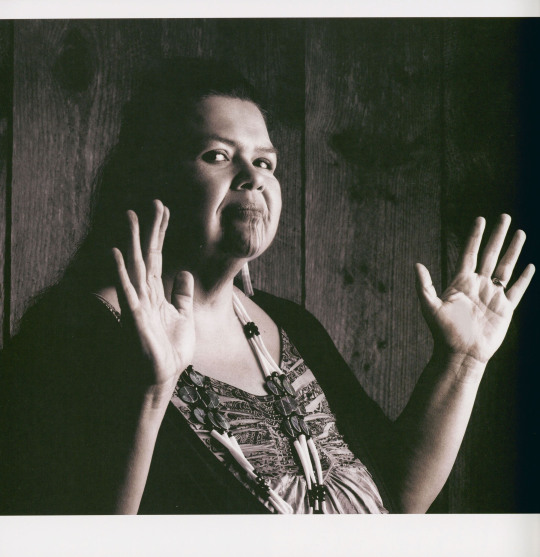
MARVA SII~XUUTESNA JONES Tolowa Dee-Ni' Nation, Yurok, Karuk, Wintu
Matika Wilbur will be speaking on UW-Milwaukee's campus Thursday, November 16 from 6-7p.m. in conjunction with her exhibition Seeds of Culture: The Portraits and Voices of Native American Women on view at the Union Art Gallery November 16 through December 15, 2023.
-Jenna, Special Collections Graduate Intern
We acknowledge that in Milwaukee we live and work on traditional Potawatomi, Ho-Chunk, and Menominee homelands along the southwest shores of Michigami, part of North America’s largest system of freshwater lakes, where the Milwaukee, Menominee, and Kinnickinnic rivers meet and the people of Wisconsin’s sovereign Anishinaabe, Ho-Chunk, Menominee, Oneida, and Mohican nations remain present.
#indigenous peoples' day#matika wilbur#project 562#Ten Speed Press#Native Americans#holidays#UWM Native American Literature Collecton
846 notes
·
View notes
Text
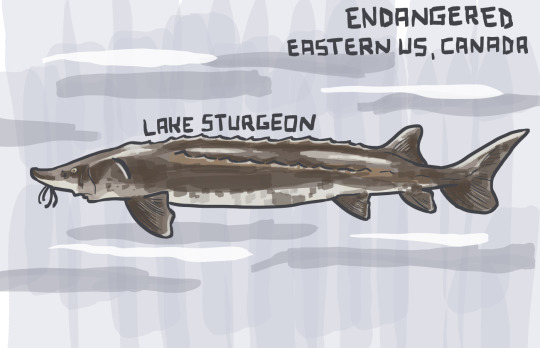
Lake Sturgeon (Acipenser fulvescens)
Lakes & waterways from the Mississippi River to Hudson Bay
Threats: overfishing, invasive species, pollution
Important in Menominee and Anishinaabe cultures
#dinosaur fish#can live up to 100 years and over 7 feet long#lake sturgeon#Acipenser fulvescens#great lakes#fish art#fish#freshwater fish#sturgeon#usa#canada#north america
127 notes
·
View notes
Text
Regarding this post going around:

Recommend checking out an article by Kasey Keeler and Ryan Hellenbrand, published at Edge Effects in 2021, which, aside from addressing the Ojibwe story about the Nanabozho fighting against logging, also describes the origin of Paul Bunyan as an icon of clear-cutting timber industry and, later, as a symbol of the advent of the US federal government’s “German-style” forestry management.
Some quick tidbits from their article:
- References to Bunyan appear in local print media from the 1890s onward, but Bunyan became more widely known in 1916 after a scholarly publication about the folklore. In the same year, 1916, an important mass media pictorial representation was made in a promotional pamphlet by the marketing team of a major logging company as a move to give them a folksly and “local” charm as the corporation expanded from Minnesota to California.
- That same logging company had owned the land that would become both Paul Bunyan State Forest and Chippewa National Forest.
- The first national forest created by act of Congress rather than presidential proclamation was actually Chippewa National Forest, which has been described as “a laboratory” to solve “the Indian problem” and discipline/contain Ojibwe people.
- Paul Bunyan was a sort of icon of German folklore in the region. Ironically, even though Bunyan was originally associated with clear-cutting, it would in fact be "German-style” forestry policy that (in Minnesota and later across the US) replaced the original clear-cutting industrial extraction methods with a "modern" and "sustainable" management approach meant for "sustained yield" (which still just treats forests as a resource to be extracted for profit).
---
Anyway, some images, captions, and text from the article [all text below is excerpted from the article]:
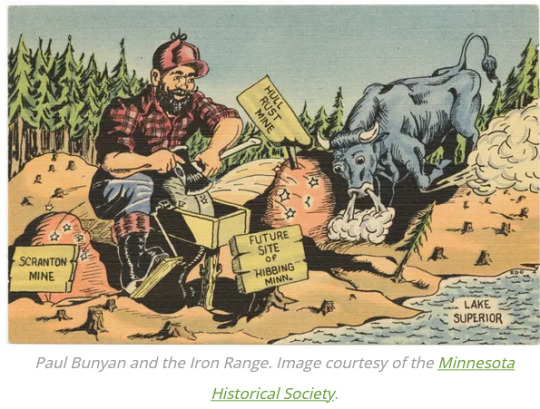
Across the Northwoods, a geography that spans the U.S.-Canada border, stories are used to make and claim space. [...] Throughout northern Minnesota, legends of Paul Bunyan, the fictional giant lumberjack, have been used to claim space. [...] Bunyan has been credited with creating Minnesota’s 10,000 lakes, the Mississippi River, and the Grand Canyon, while simultaneously logging millions of acres of forest. [...] Together, we juxtapose the history of two forests -- the Paul Bunyan State Forest and the Chippewa National Forest -- to reveal how German settlement, logging, and forestry have contributed to placemaking narratives, and how [...] nostalgia links past and present. Paul Bunyan’s literal and figurative imaginings advance American Indian erasure narratives, leading to the invisibility of these same communities today. [...] The Northwoods have been popularized and imagined as America’s version of northern Europe. [...] Across Minnesota, towns like New Ulm, New Munich, Heidelberg, and Luxemburg bear witness [...]. More recently, Native scholars Michael Dockry and Christopher Caldwell have examined [...] “the Menominee people’s profound sense of place and their intimate relationship with place.” [...]
---
Ojibwe dispossession, well underway by the late nineteenth century, is not told in any Paul Bunyan story. [...] The "heroic labor" of logging formed a significant portion of Great Lakes region economies [...] on the heels of, and entangled with, Ojibwe dispossession. [...] Formally established in 1908, the 1.6-million-acre Chippewa National Forest (CNF) lies nearly contiguous with the Leech Lake Reservation. [...] [T]he CNF was the first national forest created "for the benefit of [American] Indian people." [...] In 1902 came the Morris Act. Authored by [a] Duluth congressman [...], the act "created the first forest reserve established by congressional action rather than presidential proclamation." The act established the 225,000-acre Minnesota Forest Reserve as a “compromise,” a way to tackle the “Indian problem” while allowing for timber harvest. Here, Ojibwe homelands became “a laboratory for the first comprehensive forest management plans undertaken by a federal agency.” In 1928, the forest was renamed the Chippewa National Forest, as it remains today.
---
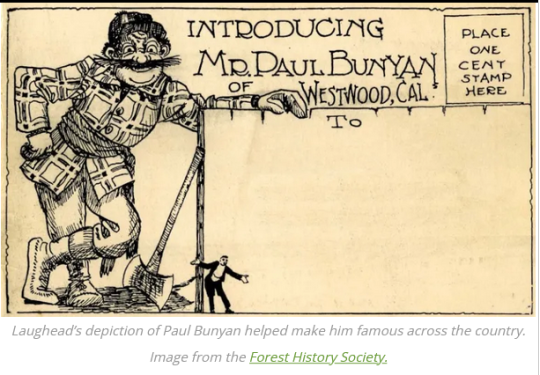
While the Chippewa National Forest forces us to consider the many ways logging and forestry has usurped American Indian peoples’ access to land, the nearby Paul Bunyan State Forest encapsulates the material legacy of symbolic myth. [...]
Officially recognized in 1935, the Paul Bunyan State Forest evolved from the site of the Red River Lumber Company sawmill. Founded in 1884, the Red River Lumber Company (RRLC) directly participated in and contributed to Ojibwe dispossession. By the end of the nineteenth century, he RRLC had purchased most of the land that comprises the present-day Pual Bunyan State Forest, milling millions of board feet of lumber at the company town of Akeley. [...]
The expansion of RRLC to California precipitated another key move: using Paul Bunyan in their marketing. William B. Laughead (pronounced Log-head), advertising manager in 1914 and a logger himself, spun another Paul Bunyan tale for the promotional booklet “Introducing Mr. Paul Bunyan of Westwood, Cal,” which included Bunyan’s first pictorial representation. This marketing campaign relied on the new and growing nostalgia for the grand logging days in the Great Lakes to keep the transcontinental corporation rooted in place.

With logging long established throughout the Great Lakes region, the ecological damage was clear. To remedy this, in the mid-1930s (German) forestry was introduced to manage timber on a sustained yield base. This, then, is the irony of the Paul Bunyan State Forest: named for an American legends who is said to have literally cleared the path for settlement, forest management now proposes to maintain the integrity of the forest. [...]
Though Paul Bunyan narratives dominate the landscape of the Northwoods, if we look closely we can see the ways Native people resist the legendary exploits. Indeed, a lesser-known Ojibwe oral story reminds us that the Anishinaabe people, their culture, and their histories will always prevail over dispossession and logging. In the story, Nanabozho, an Ojibwe trickster or cultural figure, confronts Paul Bunyan, who had already logged off most of the northeastern states before making his way to Minnesota. Nanabozho tells Paul to leave, to not log any more timber. A fight ensues, and [...] Nanabozho swings a Red Lake walleye at Paul, knocking him off his feet. As Paul stumbles, Nanabozho pulls at Paul’s whiskers, making him promise to leave the area. This is why, today, Paul Bunyan does not have a beard and why he is facing west at the statue on Lake Bemidji, as he prepares to leave the region.
This is also why we have the Chippewa National Forest, because Nanabozho and his Ojibwe kinsmen saved it from being logged. It is this contemporary narrative that highlights the complexity of Ojibwe storytelling [...].
---
Images, captions, and text as published by: Kasey Keeler and Ryan Hellenbrand. “Paul Bunyan and Settler Nostalgia in the Northwoods.” Edge Effects. 2 December 2021. [Bold emphasis and some paragraph breaks added by me.]
#abolition#ecology#indigenous#great lakes#imperial#colonial#ojibwe#victorian and edwardian popular culture#tidalectics#imperial forestry#multispecies#interspecies#geographic imaginaries
383 notes
·
View notes
Text
a rating of places in wisconsin
hudson: i was born there. it’s fine. the hospital is shit though. 4/10
ellsworth: i only go there for the 10/10 creamery. 6/10
river falls: hell on earth. i love seeing them fail. totally have no connection to rf at all. 2/10
amery: cute. 3/10
byron (fdl): 10/10 for my grandma ❤️
menominee: it’s fine. 4/10
turtle lake: nice lake. 4/10
appleton: i think there’s a water park here? idk. 3/10
barron: hell. file a restraining order. 3/10
baraboo: awwwww. 5/10
mauston: 9/10
black river falls: you wanna be river falls sooo bad. 4/10
eau claire: idc. 3/10
madison: 😀. 2/10
prescott: i think they have a clock or something. 5/10
the dells: got pickpocketed there like i was in victorian england. 3/10
somerset: several people got stabbed there. 3/10
deer park: ❤️. 8/10
4 notes
·
View notes
Note
hi, hello! so, i'm working on a rpg and can never have too many face claims to put as suggestions for prospective applicants so i was wondering if i could possibly get a list of your favorite indigenous fcs aged 25+? i'm a firm believer of ' there can never be too many native characters in the rpc ' but despite being native myself I can't think of that many. thank you in advance!
indigenousfcsdirectory.tumblr.com/ is a fantastic place to start but here are some people with a bunch of resources that'd be great for rpgs!
Third gender:
Kiley May (1987) Cayuga and Mohawk - is two-spirit genderqueer trans woman (she/they) and is queer.
Ellyn Jade / Jade Willoughby (1990) Ojibwe, Afro Jamaican, Taíno, British - two-spirit - she/her - not straight otherwise unspecified, has nephrotic syndrome and celiac’s disease.
Non-binary:
Charlyne Yi (1986) Yuki, Kapampangan Filipino, Korean, Mexican, Spanish, Irish, French, and German - is non-binary (they/them) and queer.
Morningstar Angeline (1990) Navajo, Blackfoot, Chippewa Cree, Nez Perce, Shoshone, Mexican, and Unspecified White - is non-binary (they/she) and pansexual.
Women:
Jennifer Podemski (1974) Saulteaux, Ojibwe, Lenape, Metis, and Polish Jewish - has Chronic Lyme Disease.
Amara Zaragoza (1980) Shawnee, Mexican of Purepecha descent, and German - has Multiple Sclerosis.
Jana Schmieding (1981) Miniconjou Lakota Sioux, Sicangu Oyate Lakota Sioux.
Jennifer Pudavick (1982) Metis.
Cara Gee (1983) Ojibwe.
Heather White (1983) Mohawk / Nakoda Sioux.
Jessica Matten (1985) Red River Metis of Cree and Saulteaux descent, Chinese, French, British, and Ukrainian.
Elle Maija Tailfeathers (1985) Kainai Blackfoot and Northern Sami.
Maika Harper (1986) Inuit.
Nathalie Kelley (1985) Argentinian, Quechua of Peruvian descent.
Kiley May (1987) Cayuga and Mohawk - is two-spirit genderqueer trans woman (she/they) and is queer.
Sofiya Cheyenne (1991) Taino, Dominican, Syrian, and Italian - has Spondyloepiphyseal Dysplasia Congenita.
Tanaya Beatty (1991) Da’naxda’xw and Himalayan.
Rose Matafeo (1992) Samoan / Scottish and Croatian.
Kawennáhere Devery Jacobs (1993) Mohawk - is queer.
Yalitza Aparicio (1993) Mixtec and Triqui.
Frankie Adams (1994) Samoan.
Khadijha Red Thunder (1994) Chippewa Cree, African-American, Spanish - is pansexual.
Coty Camacho (1995) Mixtec and Zapotec - is pansexual.
Chase Sui Wonders (1996) Tahitian, Chinese, Japanese, and Unknown White.
Alaqua Cox (1997) Menominee and Mohican - is Deaf and is a leg amputee.
Morgan Holmstrom (1997) Metis of Cree descent, Ilocano Filipino, and Sambal Filipino.
Madeleine Madden (1997) Gadigal, Eastern Arrernte, Kalkadoon and White.
Amber Midthunder (1997) Hunkpapa Lakota, Hudeshabina Nakoda, Sissiton-Wahpehton Dakota, Thai-Chinese, and White.
Men:
Gil Birmingham (1953) Comanche.
Benjamin Bratt (1963) Peruvian of Quechua descent, German (including Sudeten German), and English.
Keanu Reeves (1964) Kānaka Maoli, Portuguese, English, Scottish, at least 1/16th Chinese, remote Dutch / English.
Zahn McClarnon (1966) Irish, Polish, Hunkpapa Lakota and Sihasapa Lakota.
Michael Greyeyes (1967) Plains Cree.
Marcus LaVoi (1968) Ojibwe.
Robbie Magasiva (1972) Samoan.
Taika Waititi (1975) Māori, as well as distant British Isles, possibly French-Canadian / Irish, English, Scottish, Northern Irish, one quarter Ashkenazi Jewish.
Jesse Williams (1980) African-American, Seminole / Swedish.
Tenoch Huerta (1981) Mexican of Nahua, Purepecha, and Spanish descent.
Uli Latukefu (1983) Tongan.
Bobby Wilson (1984) Sisseton Wahpeton Oyate Dakota Sioux.
Alex Meraz (1984) Mexican of Purepecha descent.
Martin Sensmeier (1985) Tlingit, Koyukon, Eyak, Irish, and German.
Cooper Andrews (1985) Samoan / Hungarian Jewish.
Kalani Queypo (1986) Blackfoot, Kānaka Maoli, and Swedish.
Kiowa Gordon (1990) Hualapai, English, Scottish, Danish, Manx.
Richard Harmon (1991) Mi'kmaq, French, Italian, English.
Jordan Connor (1991) Chinese, Vietnamese, Thai, Indonesian, Papua New Guinean, Samoan / Croatian, Spanish, Greek, Italian.
Aason Nadjiwon (1992) Ojibwe and Afro Jamaican.
Angel Bismark Curiel (1995) Taino, Afro Dominican, Spanish - has asthma and a heart murmur.
Cody Christian (1995) Penobscot, Passamaquoddy / English.
Happy rping!
12 notes
·
View notes
Text

The National Park Service has approved the Menominee Indian Tribe's nomination of a culturally significant site to the National Register of Historic Places. The land is located where a controversial gold mine is set to be developed.
Last year, historic preservation boards in Wisconsin and Michigan approved the nomination of Anaem Omot, also known as the Dog’s Belly. The site on the Menominee River includes the Sixty Islands area where the tribe once lived, and it contains the tribe's dance rings and burial mounds.
2 notes
·
View notes
Text
Friday's Prep Football Scores
Friday's State Football Scores.
The Associated Press PREP FOOTBALL= Abundant Life-St. Ambrose 52, Valley Christian 8 Algoma 62, Gillett 26 Almond-Bancroft 66, Menominee Indian 0 Amherst 25, Weyauwega-Fremont 21 Aquinas 45, Westby 0 Arcadia 20, Black River Falls 8 Arrowhead 46, Waukesha West 7 Auburndale 28, Abbotsford 7 Badger 34, Elkhorn Area 7 Baldwin-Woodville 40, Osceola 7 Bangor 28, Cashton 21 Bay Port 19, De…
0 notes
Text
They Lived to Tell the Tale. . . . Or Did they?
Did the long-lost heir to the throne of France once live in De Pere, Wisconsin? In 1853, an Episcopal minister named Eleazar Williams stunned America, with the claim that he was in fact Louis XVII, the son of Louis XVI and Marie Antoinette, the monarchs beheaded during the French Revolution. No matter that their son, Louis, who was eight years old at the time his parents were guillotined, was supposed to have been an "imbecile" and was imprisoned in a tower, where he died. However, it was rumored in France that the prince, or dauphin, as he was known, had been spirited away from the tower and another child put in his place. The dauphin, it was alleged, was sent to safety in America, to be raised among the St. Regis Mohawk tribe on the shore of Lake Champlain in New York State.
To those who wanted to believe, it didn't seem to matter that Eleazar Williams was at least five years too young to have been the dauphin. But they did have a few good reasons to think that this educated missionary might be the lost prince.
The scheme that brought Williams to Wisconsin in the first place was hardly any less strange or grandiose that his later claim to French royalty. His plan had been to create an "Indian Empire" in the Fox River area, of which he would be the sole dictator. He had been a missionary to the Oneida in New York State and had talked several bands into coming with him to start this amazing enterprise. (There was also pressure on the Oneida to leave New York because the state had its eye on their lands there.)
Williams arrived in Wisconsin in 1822, and the following year he married a young girl of fourteen who was part Menominee. Once in Wisconsin, he continued to work with those Oneida who had followed him west. He set up a school and translated hymns and parts of the Bible into their language, in which he was fluent. Williams and the Oneida also purchased acreage from the Menominee and Winnebago (Ho-Chunk) nations. But things didn't go well.
Williams's grand scheme was brought down by fighting and mix-ups between the settlers from New York and the original owners of the Fox River land, and it wasn't long before Williams was held in some disregard by people from all the grounds involved in this "empire."
Then something strange happened. In 1841, the Prince de Joinville, the son of Louis Philippe, the latest occupant of the French throne, came all the way across the ocean to visit Eleazar Williams. Louis Philippe sent Williams a gift of expensive books, and according to Williams's diary, which is preserved in the State Historical Society of Wisconsin, the prince told him of his true identity and offered a huge sum of money if he would give up his claim to the French throne. Williams refused.
Other sources say it was a lawyer who first advised Williams of a facial resemblance to the lost dauphin. However, all sources agree that the Prince de Joinville really did visit Williams in Wisconsin. Either way, it was enough to convince the missionary and several prominent members of his church that he was indeed the lost dauphin. In 1853, an Episcopal clergyman wrote a book called The Lost Prince to convince the world that Eleazar Williams was truly the son of Louis XVI and Marie Antoinette, and Williams developed something of a popular following. Evidently, he did bear certain scars that matched those of the dauphin, and several doctors testified that Williams was of European, not Mohawk, ancestry. Interestingly, according to a Wisconsin Oneida story, Williams's Mohawk parents were given a very sick baby boy to adopt by two white men. However, the lost dauphin was hardly a baby when he purportedly would have been brought to America.
Williams took advantage of his newfound celebrity status to return to New York, where his followers built him a French-style château. He spent all his time studying French documents, trying to prove his origins and becoming more and more unhinged in the process. He once offered to sell the journals of the French explorer Jacques Marquette, which of course he did not have, to New York State. Toward the end of his life, Williams succumbed to paranoia, believing that unknown assassins were after him. He died in 1958 in his New York château, far from his great Indian empire, in a room where he hung a fancy silk ball gown on the wall. On his deathbed, he told those attending him that the gown belonged to his mother, Marie Antoiette.
Williams's wife remained in their Wisconsin home, which had a sweeping view of the Fox River below. Today, the cabin's flagstone foundation can still be seen in what is now Lost Dauphin Park, on the west bank of the Fox on Highway D. There's a historical marker in the park that asks, WAS HE THE LOST DAUPHIN? DNA analysis technology could probably answer that question now; maybe someone will take on the challenge and find out whether Louis XVI and Marie Antoinette's son really did walk among us along the Fox River.
0 notes
Text
My Cherokee Princess

It's a tale as old as bloodlines.
In honor of Canada's observance of National Indigenous Peoples Day, I want to talk about the Indigenous North American myths in the closets of my family history.

Before I get to that, however, I want to highlight some amazing, educational, funny, dedicated, and/or crafty Indigenous creators or brands I follow. They are not listed in a particular order, and this is not a comprehensive list. I do my best to only use the names and titles that the individuals publicly use themselves. Please let me know of corrections!
None of the links I'm including in this post are affiliated or endorsed in any way.
Birdie Sam, T'lingit
Bisan Owda, Palestinian
Angeline Boulley, Nish Kwe
Ari Tison, Bribri
Melissa Blair, Anishinaabekwe
Dani Trujillo, Indigenous and Chicana
Azalea Crowley, Kānaka Maoli and Filipino American
Ida Helene Benonisen, Sámi - Reconnecting
One Way Sky, band, Gila River Indian Community and the Tohono O'odham Nation
Turanga Morgan-Edmonds, Māori
Yolteotl Creations (Angie Zuzeth), Tongva - Reconnecting
Mozart Gabriel, Taos Pueblo and Diné Navajo Salt Clan
Birdy Brzezinski, Menominee/Potawatomi
Paaka Davis, Māori
Che Jim, Diné, Nishnaabe, and Chicano
Vanessa Brousseau, Inuk
Waŋblí Luta Win, Sicangu and Oglala Lakota
Ray Tony Charlie, Coast Salish Elder
Hāwane Rios, Kānaka 'Ōiwi
Lily Hi'ilani Okimura, Kānaka Maoli
Nikki Apostolou, Kanien'kéha
Kayuula Nova, Inuk
Tse shá’íí Chíníí, Lipan Apache and Shoshone
Next, I want to share some websites (also in no particular order and non-comprehensive) that I'm currently adding to a Linktree that I hope to air soon.
Land Back
Protect Uncontacted Tribes Petition
Helping Homeless Keiki Succeed
Demand a Ceasefire in Gaza
Orange Shirt Society
Native Justice Coalition
MMIWUSA
Defense for Children International Palestine
Indian Residential School Survivors Society
Council for Native Hawaiian Advancement
Lāhui Foundation
Palestine Children's Relief Fund
International Work Group for Indigenous Affairs

A Little Background
It was said my paternal side had distant blood relations to the Apache, Blackfoot, Cherokee, and Comanche nations (as well as French and English), while my maternal side had distant blood relations to the Sioux Confederacy (as well as Scandinavian and Irish).
As a child, I took this at face value. I thought surely the elders of my family would know with certainty who we were and where we came from. As an adult, I know better.
Raised with my paternal family, we "knew" we had Native American blood, but it wasn't something to specify outside of the home. My Pawpaw would tell me since we didn't live the way Native Americans did, it wasn't right to call ourselves that. We were proud Cajuns, and that's all anyone else needed to know. At the time, and even among some today, it's believed that to be Cajun automatically makes you at least part Native, though that's a false generalization.
My mother never spoke much about the alleged Sioux connection within her family. It was just a "truth" passed down. She used to call me her "Indian baby" [mega cringe to think back on] due to my tanned skin when I was born and how dark my tan could get as I grew. In elementary school, I was called an "Indian Coonass" and was relentlessly told that my skin wasn't tanned, it was dirty. Spoiler: No, it wasn't.
Whether I was Native American or not, it became a minute piece of my identity—a negative one, at that. By middle school, I rejected the Cajun and Native American identities that were forced on me and I stayed out of the sun as much as I could. By high school, I was no longer fluent in Cajun or Metropolitan French, had largely dropped my accent, and all thoughts of being Native American or Cajun were banished to the void.
After I left Louisiana, my actual knowledge of Native American issues began to deepen, and it finally started sinking in that the family lore was likely wrong. I never considered myself Native American again, as I doubted I would find proof to the contrary.
Nearly Caught Up
It was about this time that I initially made my first family tree on Ancestry.com. I had multiple reasons for doing so, but it was in part to set my familial record straight. I wanted to prove once and for all that we had no Native American blood or affiliations to stop the perpetuation of the Cherokee Princess myth. It was literally the least I could do.
I realized fairly quickly that I didn't know much about my relatives. I didn't care to know my biodad's side of the family that I already knew, and my mother's side had always been somewhat of a mystery.
Thankfully, the family members that I kept in my life were able to give me a great headstart. Sadly, I didn't know much about how to research family history at the time. When I kept hitting brick walls, I got bored and put it down. It was largely forgotten about for years.
In 2016, I discovered Find a Grave. I regularly visit cemeteries, so it seemed like a great idea to help connect the dead to their living or departed families. It gave me a chance to discover more about these long-forgotten people and to tell their stories—to let them live if but for a moment in someone's consciousness.
While researching, I discovered multiple other sites and tools. It eventually led me back to my family tree. This time around, I've learned more than I ever thought I would. As I added individuals and family to my tree, it was amazing to make speculative connections from the past to things about me now. I've always been afraid of sailing across the ocean. Could that be generational trauma that influenced my genes from my ancestors and their families dying aboard ships during Le Grand Dérangement?
Now, as I briefly mentioned in my essay, Happy National DNA Day!, I have 0.3% Indigenous American traces in my DNA. This lends credence to having a Native American ancestor. Is it on my maternal side? Paternal? Who knows, because I haven't definitive proof that the individual even exists.
23andMe traces back roughly 8 generations, so I have an approximate time frame. That's not overly helpful when I can't even make it past 3rd great-grandparents on some branches. Still, I've ended up with 3 unverified possibilities.
"Potential" Indigenous Ancestors
Marie "Madam Treville" Lantier
The first possibility is my supposed paternal 4th great-grandmother, Marie. She was an alleged Indigenous traiteur who lived in Egan, Acadia Parish, Louisiana, USA. I learned of her through a distant relative that I met while inquiring about my 3rd great-grandmother Mary Louise (Marjolet) Simon. No sources or additional information were given, save for the warning that my relative couldn't verify Marie existed. Neither have I.
Joseph Doucet
The second possibility is my paternal 5th great-grandfather (of a different lineage), Joseph. Other descendants of his have accepted the claim that he is Joseph "of Atakapa" Doucet. Granted, I haven't done a lot of research on this family unit, but I did make it a point to look into this for a few days.
According to a French adventurer named Louis LeClerc Milfort, Joseph was a European Jesuit who had been chosen by a band of Atakapa Natives to be their chief and had been living with them for barely over a decade with his six children.
I've read and reread the entry Milfort wrote in 1781 that discusses this encounter, and I cannot rightfully claim that my ancestor Joseph Doucet is Joseph "of Atakapa". There is no substantial identifying information that possibly links the two. For one, it never mentions Joseph's surname. As a matter of fact, these are the only two times his name is even mentioned.
"He told me that his name was Joseph [. . .]" "[. . .] I took leave of Joseph and of the Atakapas [. . .]"
The entry doesn't list a wife, and the only wife I have a record of is Celeste Bellard, but they didn't marry until 1805. The only children I have a record of are their two children, the first (my ancestor) was born after the entry. None of the six children mentioned in the entry were named.
"I have six children whom I love a great deal, and with whom I want to end my days."
There's also an issue with the timeline. Based on the father I have listed for my Joseph, he couldn't have been born before the late 1760s. However, based on the listed siblings I have for him, it's more likely he was born in the early to mid-1770s. This would put him at approximately 11 years old or younger. That's pretty young to have 6 kids and be a chief. Even if you assume he was born in the late 1760s, that really only tacks on an extra few years.
Based on a lack of substantial information and evidence, as well as my observations, I don't consider my Joseph and Joseph "of Atakapa" to be the same individual.
Germain Doucet
The last possibility is Joseph Doucet's 3rd great-grandfather, my 10th, Germain. According to the Mi'kmaq Nation's tribal pages (which has since been modified and no longer shows this passage) said:
"Germain Doucet, born 1641, is a Mi’kmaq man with a Turtle Island YDNA haplogroup, his lineage founded a ship building company that is still in business today, the family-owned fishing schooners and some Doucet men were registered owners of ships in the international shipping industry during the early 1700s. Germain and his descendants are Mi'kmaq men and members of the Mi'kmaq Tribe."
Now, there is a new passage that reads:
"The genealogy of the Doucet Turtle Island YDNA haplogroup descending from Germain Doucet raised by the French colonist, Germain Doucet is possibly the YDNA male clan lineage of the Membertou family of the Mi’kmaq Tribe. DNA testing of the 1610 Wampum Belt Treaty with Pope Paul V could confirm Turtle Island YDNA and MTDNA haplogroups of all who have touched the 1610 Wampum Belt Treaty, including Pope Paul V. DNA is a molecular clock. Because the identity of Germain’s mother is not recorded it is unknown what the mtDNA haplogroup is of Germain’s mother. Autosomal DNA test results of Germain and his wife Marie Landry’s descendants will eventually assist in the triangulation of kinship relationships to identify and confirm the identity of Germain’s mother and her relationship to the Membertou family."
Due to the Native Heritage Project, it seems beyond a shadow of a doubt that Germain is indeed a Mi'kmaq Native. I don't count him as an ancestor yet, despite getting a DNA match with another descendent of his, because I haven't done my own research and collected documented evidence that I'm a direct descendent of his and Mary/Marie Landry.

So. . . Am I Indigenous? Can I claim Indigeneity and join a tribe?
What happens if I can definitively prove these three ancestors (or anyone else) are Indigenous? Does that make me Indigenous? Well, in the most basic of ways, yes. I have Indigenous American DNA, so to that extent, I am a wee bit Indigenous American. Does that mean I get to claim Indigeneity? No, it certainly does not. Can I join a tribe? No, I certainly cannot.
While some tribes or individuals are quick to genuinely welcome anyone with a single drop of Native blood with open arms, that isn't the rule, and it shouldn't be expected or demanded by white folk who get excited at trace amounts of Native DNA.
According to the Native Governance Center, "about 70% of the federally recognized Native nations that share geography with the United States use blood quantum as a metric for citizenship." Generally, you'd need about 25% of your DNA to be Indigenous American to be recognized as such. I have less than 1%. How could I seriously justify making such a claim about myself? How could I seriously think I have a rightful place within a tribe?
Being Indigenous
Due to the history of Indigenous people being stripped of their land, families, spirituality, and other cultural and religious practices, many tribes and individuals are stringent on who can call themselves Native. Many white folks get up in arms about this, calling it gatekeeping and racist, when in actuality it's a safeguard against further whitewashing and colonization. It's a protective barrier against those who willy-nilly want to be "Indian Princesses" or want to reap the few benefits that Indigenous people can get.
This brings me to the term "Pretendian". A Pretendian is someone who is not of Native descent, typically knows that they aren't, but still peddles the false narrative that they are in order to capitalize off of the (usually) stereotypical identity/product/service. This term also encompasses my family, even if we assumed it to be an honest mistake. The issue is that for generations we blindly accepted that we were Indigenous, took on Indigenous trauma and triumph that we had no right to, without ever looking to verify it.
Pretendians happen for many reasons. Some are intentionally malicious while others are completely innocuous, or somewhere in between. It could be shame over the atrocities ancestors committed against Natives, assuaged by assuming a Native identity. It could be for a leg-up on land claims over other colonizers. It could be that other races/ethnicities would rather be thought of as Native instead of their actual race/ethnicity. It could be that a non-Native family lived among Native families, and over time the story changed to the non-Native family being a Native family.
No matter the reason, it's never a good excuse to continue perpetuating this harmful practice when you either know better or could easily learn better in 2024.
Indigenous people have always deserved better from us, and we've failed them at every turn. They simply want their right to exist as they please and return to being stewards of the land we've decimated.
Indigenous Voices
There is still a lot that I don't know about Indigenous issues. Am I using the proper terms? Is the history I reference/know true or colonized and whitewashed? Am I misrepresenting a people I'm not part of? What if there are conflicting viewpoints among the same group or individuals?
Until I get checked, I won't know.
The important part of striving to be an ally and accomplice to Indigenous people is accepting that because you're not of them and don't share their experiences, you'll likely never know everything you should or want, but you should never stop learning what you can.
It's also important to accept that you'll be checked at least once as long as you're participating in discussions involving Indigeneity. I've been checked multiple times over the years, most recently by a Romani person. Due to listening to other Romani voices, I pushed back against a picture posted on Facebook that used the g-slur. It definitely wasn't used in an intentionally offensive way, but I'd learned that as an ally and accomplice, I should still push back.
I wasn't aggressive but offered an alternative picture that didn't use the word with an explanation of why. Then the Romani person confronted me and told me that I shouldn't speak on behalf of their people and that they saw no issue with the use of the word. What should I do in that situation? There are conflicting voices and I'm being publicly reprimanded.
When Indigenous people (or anyone of any race/ethnicity/nationality) use their voice to correct you on topics that pertain to them, you should put your pride and ego aside to listen. Could they be way off-base? Sure. They're human, too. Does an individual or tribe speak for all individuals or tribes? No, humans are too varied for that kind of overarching consensus (most of the time, anyway).
However, it's worth the time to reflect on what was said to you (especially if it triggers you). You might discover a mindset or behavior that you never realized was problematic.
For me, I was triggered momentarily when the Romani person corrected me because I was merely trying to do what I was asked to do in a situation where the slur was used and then suddenly I was being scolded for interfering. It was contradictory and confusing, which can easily lead to irritation or even aggression.
Instead of arguing, I politely explained why I interjected, that I accepted their voice on this topic, that I apologized, and that I would use more caution in the future. Afterward, I was still a bit spiffed at the way I was admonished, but I took time to reflect on my actions and their words.
Honestly, I'm still learning how to navigate potential similar scenarios to come, and have curtailed how often I interject on behalf of others until I figure things out. Allyship and Accompliceship are positions of constant learning and evolving. It's hard, which is why it's so easy for others to see and call us out when we're not being genuine or doing our due diligence. Besides, being an ally or accomplice can't compare to the hardships of being the actual marginalized person or community.

In Conclusion
My family, purposefully or ignorantly, are/were Pretendians, and I'm sorry from the pit of my gut for my part in it. I take full accountability for my naivety and ignorance. Despite undoubtedly having Indigenous American trace DNA, I do not and will not have the right to claim Indigeneity and all that entails.
The importance of uplifting Indigenous voices cannot be overstated. They are still fighting against the systemic and systematic oppression that endangers their rights, protections, families, practices, and land. Follow Indigenous creators, learn whose land you live on, listen to how you can help (and be flexible on the feedback you get from doing so), stop believing the racist and dehumanizing things you've been told about them, and don't make trouble that they will incur the consequences of.
#CherokeePrincess#Pretendians#Indigenous#Indigenous peoples day#Native Americans#Indigenous Americans#indigeneity#First Nations#indigenous rights#indigenous history#indigenous creators#genealogy#ancestry#family#familyresearch#ancestryblog#accountability
0 notes
Text
The History of Plymouth WI
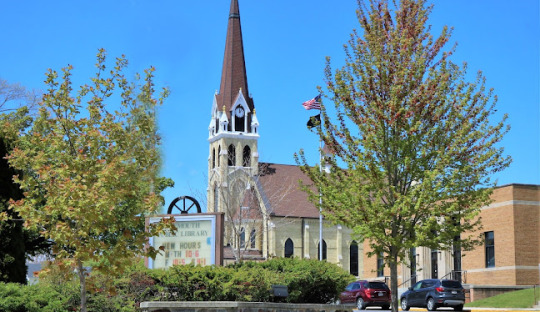
Plymouth, Wisconsin, nestled in the heart of Sheboygan County, boasts a rich history dating back to the early 19th century. Originally inhabited by the Menominee, Potawatomi, and Winnebago tribes, Plymouth's land was gradually settled by European immigrants, primarily Germans, in the mid-1800s.
The town's official founding dates back to 1845 when three settlers, Henry and George Smith, and Samuel White, established the first permanent residence. The area's fertile soil and proximity to the Sheboygan River made it an ideal location for agriculture and commerce, leading to rapid growth and the establishment of various industries, including milling, brewing, and manufacturing.
One of Plymouth's most significant historical moments occurred during the Civil War era. The town rallied behind the Union cause, sending many of its young men to fight in the conflict. In honor of their sacrifices, a monument was erected in Union Park, serving as a solemn reminder of Plymouth's contributions to the nation's history.
The late 19th and early 20th centuries witnessed further development and prosperity for Plymouth. The arrival of the railroad in 1872 enhanced transportation and trade opportunities, while advancements in technology spurred industrial expansion. The town became known for its thriving businesses, including the Plymouth Furniture Company and the Plymouth Brewing Company, which produced the renowned Old Pilgrim Lager.
Throughout the 20th century, Plymouth continued to evolve, adapting to changing economic landscapes and societal shifts. World War II brought about increased industrial activity, with local factories contributing to the war effort. Post-war suburbanization and the rise of automobile culture reshaped the town's demographics and infrastructure.
Today, Plymouth remains a vibrant community that cherishes its heritage while embracing modernity. Visitors can explore its historic downtown, characterized by well-preserved architecture and charming shops. Annual events such as the Mill Street Festival celebrate Plymouth's culture and traditions, providing a glimpse into its storied past.
As Plymouth looks towards the future, its rich history serves as a foundation upon which to build a thriving and inclusive community for generations to come.
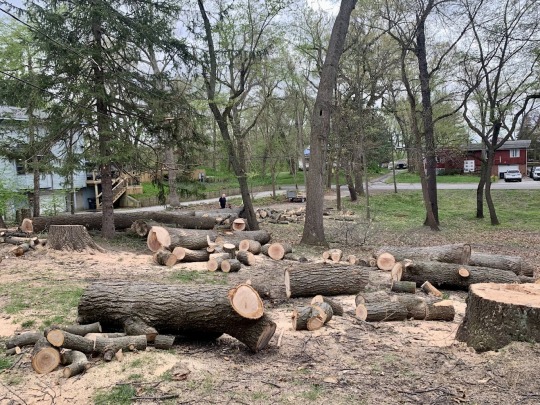
Top Chop Tree Service is more than just a tree care company; it's a testament to expertise, dedication, and a commitment to preserving the natural beauty of landscapes. With a passion for arboriculture and a focus on customer satisfaction, Top Chop Tree Service has established itself as a premier provider of tree care solutions in the community.
At Top Chop Tree Service in Plymouth WI, we understand that trees are not just part of the scenery; they are essential components of the ecosystem, providing shade, oxygen, and beauty to our surroundings. That's why we take pride in offering a comprehensive range of services aimed at promoting the health and vitality of trees while ensuring the safety and aesthetics of properties.
Our team consists of highly skilled and certified arborists who possess the knowledge and experience to handle any tree-related task with precision and care. Whether it's tree trimming, pruning, or removal, we employ industry-leading techniques and state-of-the-art equipment to deliver superior results safely and efficiently.
We also specialize in tree preservation and disease management, providing expert diagnosis and treatment plans to address various tree health issues effectively. Our goal is not just to remove trees but to preserve and protect them whenever possible, allowing them to thrive for years to come.
At Top Chop Tree Service, safety is our top priority. We adhere to strict safety protocols and procedures to ensure the well-being of our team members, clients, and properties. From thorough risk assessments to meticulous cleanup, we strive to minimize disruption and maximize safety throughout every project.
Customer satisfaction is at the core of everything we do. We pride ourselves on our professionalism, reliability, and attention to detail, ensuring that every client receives personalized service and exceptional results. With transparent pricing and clear communication, we aim to exceed expectations and build lasting relationships with our valued customers. Learn more.
Whether you need routine tree maintenance, emergency tree removal, or expert advice on tree care, Top Chop Tree Service is here to help. Contact us today to experience the difference our expertise and dedication can make for your trees and property.
Top Chop Tree Service & Land Management 1015 Jay Rd, Cedar Grove, WI 53013 920 838–0520 http://topchoptreeservice.com/
1 note
·
View note
Text
Share or view as webpage | Update preferences
DNR News
Oct. 13, 2023
Contact: Christian LeSage, 517-449-7073
Natural Resources Commission approves changes to fishing regulations
a bare outstretched hand holds a shiny silver and gray fish, with a large dorsal fin, over calm, blue water. Mature green conifers in back
Several changes to statewide and local fishing regulations were approved Thursday by the Michigan Natural Resources Commission during its meeting in Escanaba. The updated regulations, outlined below, take effect Friday, Oct. 13, 2023.
Statewide: The phrase “attempting to take” has been removed in reference to fishing for Arctic grayling (shown above) in Michigan since grayling currently are being raised in preparation for a limited, future stocking program. This change will allow anglers to catch and immediately release Arctic grayling. It will not allow anglers to possess the species.
Statewide: A northern pike regulation wording change now states where northern pike 24 inches or greater are allowed on waters where up to five northern pike of any size may be taken, with only one 24 inches or greater allowed in the daily possession limit.
The following waters were added to the list of waters where up to five northern pike may be kept, with only one 24 inches or greater allowed in the daily possession limit:
Black Lake tributaries and Black Lake River from Alverno Dam upstream (Cheboygan County).
Norway and Rock lakes (Dickinson County).
Chain Lakes (Iosco County).
Dawson Lake (Iron County).
Lake Ann (Menominee County).
Additional approved regulations include:
Dowagiac River (Berrien County): The upstream boundary for Type 4 trout regulations has been changed from “Niles Dam site” to “from source downstream” since the dam has been removed.
Reid Lake (Alcona County) was removed from Type B trout regulations.
Youngs Lake (Luce County) was removed from Type A trout regulations.
Half Moon Lake (Muskegon County) was removed from Type C trout regulations.
The online Michigan Fishing Guide (available at Michigan.gov/DNRDigests) and regulations hotline (888-367-7060) will be updated to reflect these changes.
For more information on fishing opportunities and resources – including licenses, locations, beginner tips and more – visit Michigan.gov/Fishing.
0 notes
Text













Voices of the Land
What better way to celebrate Indigenous Peoples’ Day than to highlight this landmark anthology that commemorates the Indigenous Peoples of North America? When the Light of the World was Subdued, Our Songs Came Through: A Norton Anthology of Native Nations Poetry, edited by Joy Harjo with Leanne Howe, Jennifer Elise Foerster, is a curated collection that features the poetry of 160 poets each showcasing a distinct voice from nearly 100 Indigenous Nations. This is the first edition from 2020, published by W. W. Norton & Company in New York.
The anthology is the first to provide a historically comprehensive collection of Native poetry. The literary traditions of Native Americans, the original poets of this country, date back centuries. The book opens with a blessing from Pulitzer Prize winner American Kiowa/Cherokee N. Scott Momaday (1934-2024) and contains introductions from contributing editors for five geographically organized sections. Each section begins with a poem from traditional oral literature and closes with emerging poets, creating a rich and diverse tapestry of Indigenous voices.
Joy Harjo, a member of the Muscogee (Creek) Nation, is a prominent figure in the literary world. She is known for her work as a poet, musician, playwright, and author. In addition to her contributions to literature, Harjo is also a celebrated performer and has released several albums combining poetry and music. In 2019, she made history by becoming the first Native American United States Poet Laureate and only the second to serve three terms. Throughout her career, Harjo has been a vocal advocate for Indigenous rights and has used her art to shed light on the experiences of Native peoples.
The following is an excerpt from Harjo’s introduction to this work:
“The anthology then is a way to pass on the poetry that has emerged from rich traditions of the very diverse cultures of indigenous peoples from these indigenous lands, to share it. Most readers will have no idea that there is or was a single Native poet, let alone the number included in this anthology. Our existence as sentient human beings in the establishment of this country was denied. Our presence is still an afterthought, and fraught with tension, because our continued presence means that the mythic storyline of the founding of this country is inaccurate. The United States is a very young country and has been in existence for only a few hundred years. Indigenous peoples have been here for thousands upon thousands of years and we are still here.”
View other Indigenous Peoples' Day posts.
View other posts from our Native American Literature Collection.
-Melissa (Stockbridge-Munsee), Special Collections Graduate Intern
We acknowledge that in Milwaukee we live and work on traditional Potawatomi, Ho-Chunk, and Menominee homelands along the southwest shores of Michigami, part of North America’s largest system of freshwater lakes, where the Milwaukee, Menominee, and Kinnickinnic rivers meet and the people of Wisconsin’s sovereign Anishinaabe, Ho-Chunk, Menominee, Oneida, and Mohican nations remain present.
#indigenous peoples' day#When the Light of the World was Subdued#Our Songs Came Through#joy harjo#Leanne Howe#Jennifer Elise Foerster#W. W. Norton & Company#N. Scott Momaday#first nations#native americans#Native poetry#indigenous literature#indigenous poetry#poetry anthology#poet laureate
77 notes
·
View notes
Text
Wisconsin

Wisconsin is a state located in the Midwestern region of the United States, bordered by Michigan to the east, Minnesota to the west, Iowa to the southwest, and Illinois to the south. Known as the "Badger State," Wisconsin offers a wealth of history, geography, culture, and attractions that draw visitors from around the world. The state's history dates back to the indigenous peoples who have inhabited the area for thousands of years. In the 17th century, French explorers arrived in the region and established settlements, followed by British and American expansion in the 18th and 19th centuries. Wisconsin's rich history includes pivotal events such as the Black Hawk War and the Underground Railroad, both of which were instrumental in shaping social and political history in the state. Geographically, Wisconsin is unique in that it is home to both the Great Lakes and the Mississippi River, and is dotted with natural wonders like the Ice Age Trail and the Niagara Escarpment. The state is also home to a diverse array of flora and fauna, including the state's emblematic animal, the badger. Wisconsin is known for its environmental stewardship and its efforts to preserve its natural resources. Despite these efforts, however, the state is also grappling with environmental issues like pollution and habitat loss. Wisconsin offers a rich cultural scene, with music, art, and festivals that draw visitors from around the country. The state is also home to a number of famous people, from politicians like former Vice President Joe Biden to entertainers like Liberace and Dan Harmon. Visitors to Wisconsin can enjoy a diverse range of activities and attractions, from outdoor recreation to museum hopping to exploring historic sites. Whether you're looking to explore Wisconsin's unique geography, delve into its rich history, or soak up its vibrant culture, the Badger State has something for everyone.

Etymology
The name "Wisconsin" has its origin in the Wisconsin River, which was named Meskonsing by the Native Americans. The name Meskonsing roughly translates to "red stone place" or "place of the hills." The French explorer Jean Nicolet is credited with being the first European to set foot in what is now Wisconsin in 1634, and he adopted the name Meskonsing for the region. Over time, the name evolved into its current form. Some sources suggest that it was shortened to Ouisconsin or Ouisconsin by French traders and explorers, and the spelling gradually changed to Wisconsin. Another theory is that the name Wisconsin comes from the Miami-Illinois word Ouisconsin, meaning "grassy place" or "gathering of the waters." This theory is supported by the fact that much of Wisconsin is covered by grasslands and wetlands, and the state is home to numerous lakes, rivers, and streams. Regardless of its origins, Wisconsin has a rich history and culture that are intertwined with the state's name. The name Wisconsin is now synonymous with cheese, dairy products, beer, and bratwurst, as well as breathtaking natural landscapes and friendly Midwestern hospitality.
History
Wisconsin's history dates back to before European contact, when Native American tribes including the Menominee, Ojibwe, and Ho-Chunk settled in the region. In the 1600s, French explorers and traders arrived in Wisconsin and established a fur trade network. The French made alliances with some Native American tribes, while others, including the Fox and the Potawatomi, resisted their presence. During the 1700s, the French, British, and Native Americans fought for control of Wisconsin, which was strategic for its access to the Great Lakes and the Mississippi River. In 1763, the British gained control of Wisconsin as part of the Treaty of Paris that ended the French and Indian War. The British established trading posts and forts, including Fort Mackinac and Fort Crawford. In the early 1800s, Wisconsin became part of the newly formed United States. The 1803 Louisiana Purchase and the subsequent Lewis and Clark Expedition opened up the western frontier, including Wisconsin. The federal government negotiated treaties with Native American tribes to acquire their land and allow for white settlement. During the War of 1812, Wisconsin was a battleground between the British and the Americans, with major battles taking place at Fort Mackinac, Fort Dearborn, and Prairie du Chien. After the war, Wisconsin became part of the Indiana Territory, then the Michigan Territory, and finally the Wisconsin Territory in 1836. Wisconsin became a state in 1848, becoming the 30th state in the Union. In the mid-1800s, Wisconsin was an important stop on the Underground Railroad, a network of safe houses and secret routes that helped slaves escape from the South to freedom in the North. During the Civil War, Wisconsin sent over 91,000 soldiers to fight, one of the highest percentages of any state. In the late 1800s and early 1900s, Wisconsin became known for its progressive politics and social reforms, including the first workers' compensation program and the first American kindergarten. Throughout the 20th century, Wisconsin continued to be a leader in manufacturing, agriculture, and tourism. The state was also home to important civil rights movements, including the fight for desegregation in Milwaukee schools and the 1960s open housing marches in Milwaukee. Today, Wisconsin is a diverse and dynamic state with a rich history and culture. Its history, geography, and people have helped shape its unique character and identity. Pivotal events Wisconsin has been shaped by a number of pivotal events throughout its history. These events have influenced the state's culture, politics, and economy, leaving a lasting impact on its residents and visitors alike. In this section, we will explore some of the most significant historical events that have shaped Wisconsin's past and present. The Black Hawk War was a major conflict that took place in Wisconsin in 1832. The war was fought between the United States and a group of Native American tribes led by the warrior Black Hawk. The conflict was sparked by tensions over land rights and settler encroachment on Native American territories. The war lasted just a few months, but it left a lasting legacy in Wisconsin's history. The Underground Railroad was another pivotal event in Wisconsin's history. During the 19th century, Wisconsin became a key stop on the Underground Railroad, a network of secret routes and safe houses used to help slaves escape to freedom in the North. Many abolitionists and activists dedicated their lives to this cause, risking their own safety to help others. Today, Wisconsin is home to many historic sites and landmarks associated with the Underground Railroad. In addition to these events, Wisconsin has played a key role in many other historic moments. For example, during World War II, the state became an important center for war production, with many factories and industries ramping up production to support the war effort. In the civil rights movement, Wisconsin was a key battleground, with activists and advocates pushing for greater equality and civil rights for all. Wisconsin's history has been shaped by a rich and complex tapestry of events, people, and movements. By exploring these pivotal events, we can gain a deeper understanding of the state's past and present, and how it has become the diverse and vibrant place it is today.
Geology
Wisconsin's geology is a fascinating mix of varied landscapes and geological features that are uniquely formed by the state's glacial past. One of the most distinctive geological attractions in Wisconsin is the Ice Age Trail, which spans over 1,000 miles and showcases the state's glacial history. This trail features picturesque views of glacial lakes, kettles, and moraines, all created by the last Ice Age approximately 12,000 years ago. Another significant geological feature in Wisconsin is the Niagara Escarpment, which extends over 650 miles from Wisconsin to New York. The Niagara Escarpment offers picturesque views of exposed rock formations and cliffs that are up to 200 feet high in some places. Along with providing stunning scenery, the Niagara Escarpment also serves as a vital aquifer, providing valuable drinking water to Wisconsin's residents. Wisconsin also boasts a wide range of deposits of minerals and resources, including iron ore, zinc, copper, lead, and much more. In addition, over 21,000 wells are drilled in Wisconsin every year to collect natural resources such as oil and natural gas. Aside from these natural resources, Wisconsin is also home to a variety of fossilized species that hold great scientific significance. These fossils come from a range of geological formations, including Ordovician limestone and Cambrian sandstone. The state's fine-grained rocks serve as an excellent basis for studying ancient oceanic and terrestrial environments. Wisconsin's geology is a unique and integral part of the state's identity, providing a foundation for its natural beauty and resources.
Geography
Located in the Midwest region of the United States, Wisconsin is known for its diverse landscapes. To the east, the state is bordered by Lake Michigan, one of the Great Lakes, which provides a variety of recreational opportunities and scenic beauty. To the west, the state is home to the Mississippi River and the St. Croix River, offering both commercial and recreational use. Wisconsin is also home to a number of forests and parks, including the Chequamegon-Nicolet National Forest, which covers over 1.5 million acres and offers opportunities for camping, hiking, fishing, and more. The state is also home to the Kettle Moraine State Forest, which features rolling hills and glacial formations, as well as the Apostle Islands National Lakeshore, which offers opportunities for kayaking, hiking, and exploring sea caves. In addition to these natural areas, Wisconsin is also home to a number of urban centers, including Milwaukee, the largest city in the state, as well as Madison, the state capital, and Green Bay, home to the famous Green Bay Packers football team. Each of these cities offers its own unique attractions, from museums and galleries to shopping and dining. - Some of the major cities include: - Milwaukee: Known for its beer, brats, and beautiful lakefront, Milwaukee is a vibrant city that offers an array of cultural attractions, including the Milwaukee Art Museum and the Harley-Davidson Museum. - Madison: Home to the University of Wisconsin-Madison, Madison is a college town that offers a variety of cultural events and outdoor recreation opportunities, including the Olbrich Botanical Gardens and the Henry Vilas Zoo. - Green Bay: Known for its football team, Green Bay is also home to the Packers Hall of Fame, as well as a variety of other cultural attractions, including the Neville Public Museum and the National Railroad Museum. Wisconsin's geography offers a unique and diverse array of landscapes, from the Great Lakes to the rolling hills and forests of the state's national parks. Whether you're a nature lover or a city dweller, there's something for everyone in Wisconsin. Cities and regions Wisconsin is a state known for its unique blend of historical significance and modern appeal. The major cities and regions of Wisconsin offer visitors a glimpse into its fascinating culture, traditions, and lifestyle. Among the most visited cities in Wisconsin are Milwaukee, Madison, and Green Bay. Milwaukee is one of the largest cities in Wisconsin and is famous for its rich cultural and industrial heritage. Located on the shores of Lake Michigan, Milwaukee boasts a beautiful lakeside skyline and is home to numerous attractions, including Harley-Davidson Museum, Miller Park, Milwaukee Art Museum, and the Basilica of St. Josaphat. In addition, Milwaukee is renowned for its breweries and is often referred to as the Beer Capital of the World. Visitors can take a brewery tour and sample some of the finest craft beer that the city has to offer. Madison is the state capital of Wisconsin and is known for its stunning natural beauty. The city is situated on an isthmus between Lake Mendota and Lake Monona and offers visitors a wealth of recreational opportunities, including boating, fishing, hiking, and biking. Madison is also home to the University of Wisconsin-Madison, one of the largest and most prestigious universities in the country. The university campus is a major attraction and includes notable landmarks such as the Memorial Union Terrace, the Robert M. La Follette School of Public Affairs, and the Wisconsin Institutes for Discovery. Green Bay is a charming city situated on the shores of Green Bay, a sub-basin of Lake Michigan. The city is perhaps best known for its football team, the Green Bay Packers, and is home to the legendary Lambeau Field stadium. Green Bay also boasts a rich cultural heritage and is home to numerous museums, including the National Railroad Museum, the Neville Public Museum, and the Heritage Hill State Park. Visitors can also enjoy outdoor recreation activities, such as kayaking, fishing, and hiking in the nearby Bay Beach Wildlife Sanctuary and the Bayshore County Park. - Other notable cities and regions in Wisconsin include: - Wisconsin Dells - known for its water parks and scenic beauty - La Crosse - a quaint town famous for its picturesque river views and historic architecture - Door County - located on a peninsula that juts into Lake Michigan, Door County is a popular tourist destination for its natural beauty, quaint shops, and stunning lighthouses Wisconsin's cities and regions offer visitors a wide range of recreational, cultural, and social experiences. Whether you're interested in history, arts, sports, or nature, you're sure to find something to suit your tastes in Wisconsin.
Ecology
Wisconsin is home to a diverse array of wildlife and plant species, thanks to its varied geography and climate. The state's emblematic animal is the badger, which can be found in the southern part of the state. Other mammals that are common in Wisconsin include white-tailed deer, coyotes, and red foxes. Wisconsin has an abundance of bird species, with over 400 species recorded in the state. Some of the most famous birds found in Wisconsin include the bald eagle and the whooping crane. The state is also home to a variety of freshwater fish, such as walleye, muskellunge, and northern pike. In terms of plant life, Wisconsin has a rich variety of species, from forests of maple, oak, and hickory trees to wetlands filled with cattails and sedges. The state is known for its wildflowers, including the state flower, the wood violet. In addition, Wisconsin is one of the top producers of cranberries in the United States, and apple orchards are a common sight in the state's rural areas. Unfortunately, many of Wisconsin's native plant and animal species are threatened by habitat loss and degradation, as well as pollution. The state government and various conservation organizations are working to protect these important ecosystems and ensure the survival of these species for generations to come.
Biodiversity
Wisconsin is home to a great variety of plant and animal species, many of which are unique to the state. The state's geographic and ecological diversity has led to the development of a wide range of ecosystems, from wetlands to forests to prairies. The biodiversity of Wisconsin is of great value, both ecologically and economically. Wisconsin's Department of Natural Resources (DNR) is responsible for monitoring the state's natural resources and protecting endangered and threatened species. There are currently about 70 species of animals and plants that are listed as endangered, threatened, or special concern in Wisconsin. Endangered species in Wisconsin include the gray wolf, the piping plover, and the Kirtland's warbler. Threatened species in the state include the eastern massasauga rattlesnake and the Hine's emerald dragonfly. Some of the species of special concern in Wisconsin are the northern bog lemming, the long-eared owl, and the Blanding's turtle. Wisconsin's DNR works with other organizations to conserve and protect endangered and threatened species. The Wisconsin Endangered Species Program was established in 1972 and has since played a crucial role in protecting rare and threatened species. The program also aims to educate the public about the importance of biodiversity and the need to protect endangered and threatened species for future generations. Threats to Wisconsin's biodiversity come from various sources, including habitat loss, climate change, disease, and pollution. Invasive species are also a major threat to the state's native species. Invasive species such as the emerald ash borer, the sea lamprey, and the Japanese knotweed can cause significant damage to Wisconsin's ecosystems and pose a threat to native species. Efforts to protect Wisconsin's biodiversity include the restoration of degraded ecosystems, the use of conservation easements to protect habitat, and the creation of wildlife corridors to connect fragmented habitats. The state's Natural Heritage Inventory identifies areas of the state that are of high ecological value and need to be protected from development. Wisconsin's DNR also works with private landowners to encourage the protection and restoration of habitats on private lands. - the biodiversity of Wisconsin is a vital part of the state's natural heritage and contributes to the ecological and economic well-being of the state. Endangered and threatened species in Wisconsin need to be protected and conservation efforts need to be continued to prevent the loss of biodiversity in the state.

Kirtland's warbler
Climate
Wisconsin experiences a continental climate, which is characterized by warm summers and cold winters. The state lies in the Northern Hemisphere, so it also experiences seasonal changes, with distinct spring, summer, fall, and winter periods. Generally, the state has long, cold winters and short, warm summers. The climate in Wisconsin is influenced by both its location and geography. Wisconsin's proximity to the Great Lakes has a significant impact on its weather patterns. The warm, moist air over the lakes can lead to lake effect snow, causing localized heavy snowfall in areas near the lakes. In addition, the lakes moderate the temperature, keeping the areas surrounding them cooler in the summer and warmer in the winter. The western parts of Wisconsin are mountainous, which means they experience a slightly different climate than the rest of the state. There, the winters are colder and the summers are milder. The western region also experiences more snowfall than other parts of Wisconsin. Precipitation in Wisconsin is distributed evenly throughout the year, with an average annual precipitation of around 32 inches. However, droughts and heatwaves do occur occasionally. Read the full article
0 notes
Link

A Canadian exploration company with no mining experience wants to create a large open pit a mere 150 feet from the Menominee riverbank. The footprint of the proposed mine and tailings dam encompasses 1,087 acres – or 1,435 football fields. Photo by Bob Wick, BLM.
Excerpt from this story from the Earth Island Journal:
The river drains into Lake Michigan’s Green Bay, just above the city named for it. The twin cities of Menominee, Michigan and Marinette, Wisconsin both draw their drinking water from the river. Aquila Resources, a Canadian exploration company with no mining experience wants to create a large open pit a mere 150 feet from the riverbank to extract gold, zinc, and other minerals from a nearby underground sulfide deposit discovered in 2001.
The area around the site of the proposed mine is a rural-urban mix. Local residents voted overwhelmingly for Donald Trump in 2016. However, a common reverence for the health of the river has brought together unlikely allies, such as Guy Reiter (also known as Anahkwet), a community organizer from the Menominee Indian Tribe of Wisconsin, and professional musicians Dale and Lea Jane Burie.
The location of the proposed Back Forty mine project has special significance for the Menominee Nation. The Menominee’s creation story starts where the Menominee River empties into Lake Michigan. Their people occupied the Menominee River area until the colonial government forced them to cede their original territory in Michigan via a treaty in 1836. However, the Menominee Nation never gave up its right to protect its traditional cultural resources, including ancient garden beds, village sites and burial grounds that are essential to their identity. The present-day Menominee reservation is 60 miles southwest of the proposed mine.
In early 2018, the Menominee Nation filed a lawsuit in Michigan seeking to halt the project on its ancestral lands. Among other things, the suit argued that permitting for the mine should be in federal hands, not in Michigan’s.
Later that year, the Coalition to SAVE the Menominee River filed a separate suit against the US Environmental Protection Agency (EPA) and Army Corps of Engineers claiming that the agencies wrongly approved a wetlands permit for the proposed mine. The agencies had initially rescinded approval of the permit but then reversed their decision and gave Michigan’s Department of Environmental Quality (now the Department of Environment, Great Lakes, and Energy or EGLE) permission to grant it.
6 notes
·
View notes
Video
Purple House by John Gremmer Via Flickr: This purple house is found along the Menominee River near downtown Marinette, WI. I have driven by it many times, but on this day, this old car was parked in front of it, and I stopped and made a couple of images. I have no idea how old this house is, but I am amazed at the quality of work that the carpenters did then. I used my Pentax k-5 and Pentax 16-50mm lens to make this image. Processing was done in Aperture 3 and Topaz Adjust 4. Camera settings: ISO 800, Aperture f/13, Shutter 1/200, Focal length 34 mm purple victorian home decorated with ginger bread and lighting rods looking down on the menominee river Image and Haiku by John Henry Gremmer
#cities#Marinette#USA#Wisconsin#Victorian home#antique car#Menominee River#John Henry Gremmer#vintage#victorian#victoria#Victorian house#victorian houses#dream#Dream House#dream home#love#cute#adorable#lovely#historic#old#house#home#elegant#luxury#luxury home#gimme#Architecture
295 notes
·
View notes
Link
Offering a dense suburban feel, Marinette is an incredible city located on the south bank of the Menominee River. From Green Bay to exceptional inland waters to shores and more, the place has something for each outdoor enthusiast Best Things
0 notes